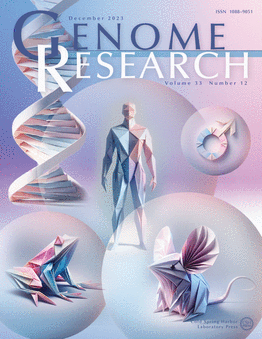Interactive visualization and interpretation of pangenome graphs by linear-reference-based coordinate projection and annotation integration
IF 6.2
2区 生物学
Q1 BIOCHEMISTRY & MOLECULAR BIOLOGY
引用次数: 0
Abstract
With the increasing availability of high-quality genome assemblies, pangenome graphs emerged as a new paradigm in the genomics field for identifying, encoding, and presenting genomic variation at both population and species levels. However, it remains challenging to truly dissect and interpret pangenome graphs via biologically informative visualization. To facilitate better exploration and understanding of pangenome graphs towards novel biological insights, here we present a web-based interactive Visualization and interpretation framework for linear-Reference-projected Pangenome Graphs (VRPG). VRPG provides efficient and intuitive supports for exploring and annotating pangenome graphs along a linear-genome-based coordinate system (e.g., that of a primary linear reference genome). Moreover, VRPG offers many unique features such as in-graph path highlighting for graph-constituent input assemblies, copy number characterization for graph-embedding nodes, graph-based mapping for query sequences, all of which are highly valuable for researchers working with pangenome graphs. Additionally, VRPG enables side-by-side visualization between the graph-based pangenome representation and the conventional primary-linear-reference-genome-based feature annotations, therefore seamlessly bridging the graph and linear genomic contexts. To further demonstrate its functionality and scalability, we applied VRPG to the cutting-edge yeast and human reference pangenome graphs derived from hundreds of high-quality genome assemblies via a dedicated web portal and examined their local genome diversity in the graph contexts.通过基于线性参照的坐标投影和注释整合,实现庞基因组图谱的交互式可视化和解读
随着高质量基因组汇编的日益普及,泛基因组图谱成为基因组学领域的一种新范式,用于在种群和物种水平上识别、编码和展示基因组变异。然而,通过生物信息可视化来真正剖析和解释庞基因组图谱仍然具有挑战性。为了促进更好地探索和理解庞基因组图,从而获得新的生物学见解,我们在此提出了一个基于网络的线性参考投射庞基因组图(VRPG)交互式可视化和解释框架。VRPG 为沿着基于线性基因组的坐标系(如主要线性参考基因组的坐标系)探索和注释庞基因组图提供了高效、直观的支持。此外,VRPG 还提供了许多独特的功能,如图内路径高亮显示组成图的输入集合、图嵌入节点的拷贝数特征、基于图的查询序列映射等,所有这些功能对研究人员处理庞基因组图都非常有价值。此外,VRPG 还能将基于图的庞基因组表示法与传统的基于主线性参考基因组的特征注释并排可视化,从而无缝连接图和线性基因组上下文。为了进一步证明 VRPG 的功能性和可扩展性,我们将 VRPG 应用于通过专用门户网站从数百个高质量基因组组装中获得的最先进的酵母和人类参考泛基因组图谱,并在图谱上下文中研究了它们的局部基因组多样性。
本文章由计算机程序翻译,如有差异,请以英文原文为准。
求助全文
约1分钟内获得全文
求助全文
来源期刊

Genome research
生物-生化与分子生物学
CiteScore
12.40
自引率
1.40%
发文量
140
审稿时长
6 months
期刊介绍:
Launched in 1995, Genome Research is an international, continuously published, peer-reviewed journal that focuses on research that provides novel insights into the genome biology of all organisms, including advances in genomic medicine.
Among the topics considered by the journal are genome structure and function, comparative genomics, molecular evolution, genome-scale quantitative and population genetics, proteomics, epigenomics, and systems biology. The journal also features exciting gene discoveries and reports of cutting-edge computational biology and high-throughput methodologies.
New data in these areas are published as research papers, or methods and resource reports that provide novel information on technologies or tools that will be of interest to a broad readership. Complete data sets are presented electronically on the journal''s web site where appropriate. The journal also provides Reviews, Perspectives, and Insight/Outlook articles, which present commentary on the latest advances published both here and elsewhere, placing such progress in its broader biological context.
 求助内容:
求助内容: 应助结果提醒方式:
应助结果提醒方式:


